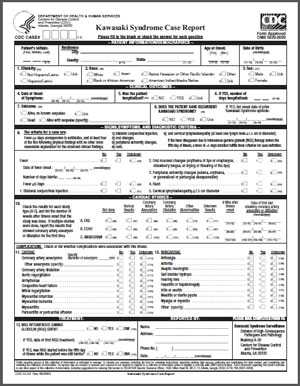About Kawasaki Disease
Kawasaki disease (KD), also known as Kawasaki syndrome, is an acute febrile illness of unknown etiology that primarily affects children younger than 5 years of age. The disease was first described in Japan by Tomisaku Kawasaki in 1967, and the first cases outside of Japan were reported in Hawaii in 1976.
Clinical signs include fever, rash, swelling of the hands and feet, irritation and redness of the whites of the eyes, swollen lymph glands in the neck, and irritation and inflammation of the mouth, lips, and throat.
KD is a leading cause of acquired heart disease in the United States. Serious complications include coronary artery dilatations and aneurysms. The standard treatment, intravenous immunoglobulin and aspirin, substantially decreases the development of these coronary artery abnormalities.
Kawasaki Disease Case Report
KD occurs worldwide, with the highest incidence in Japan, and it most often affects boys and younger children. KD may have a winter-spring seasonality, and community-wide outbreaks have been reported occasionally. In the continental United States, population-based and hospitalization studies estimate an incidence of KD ranging from 9 to 19 per 100,000 children under 5 years of age. In the year 2000, approximately 4248 hospitalizations with KD were reported among children under 18 in the US, of which 3277 (77%) were for children under 5 years of age. In 2009, the estimated number of hospitalizations with KD was 5447 (standard error [SE]=297), 4040 (SE=227) for children under 5 years of age.
CDC uses hospital discharge data, a passive KD surveillance system, and special studies to describe the incidence and epidemiology of KD in the United States. The KD surveillance system has been maintained by CDC since 1976 and is based on voluntary reporting of KD cases by health care providers and local and state health authorities. A standardized case report form is used to collect information on patients.
The KD case report form is available as a pdf document for healthcare workers to submit a report. Healthcare workers who wish to submit a report can do so by completing either the print form print form [PDF- 1 page] (i.e., print out and complete manually) or the electronic form [PDF- 1 page] (i.e., enter the data directly on the computer and then print out the completed form. Note: You may not be able to download and save the completed form if your computer’s software does not allow this feature). The completed form should be sent to the mailing address provided on the form or sent by fax to 404-639-3163.
- Page last reviewed: December 13, 2013
- Page last updated: December 13, 2013
- Content Source:


 ShareCompartir
ShareCompartir
